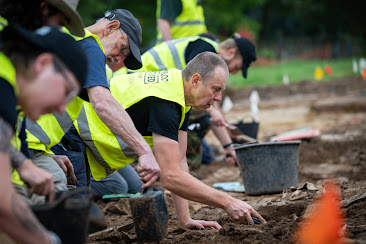Attempts to unearth grisly “secrets” from the Battle of Waterloo are, it has emerged, also helping military personnel come to terms to with their own health issues.
A team of experts and members of the armed forces from different countries, including the UK, are this week digging at a site in Waterloo, Belgium which witnessed horrific death and injury during the famous battle in 1815.
The dig, the latest in a series of such excavations, this week unearthed fresh evidence of the scale and brutality of the battle, with severed human limbs found on the site.
But, crucially, the excavation is also helping armed forces personnel, both retired and serving, with the mental health issues they suffered as a result of personal involvement in armed conflict around the world.
The tragic remains poignantly uncovered this week on the Waterloo-Braine L’Alleud border have been excavated by veterans and serving personnel who themselves are suffering from the mental and physical impact of their military service.
They include 58-year-old Jan Verhoeven, from near Antwerp, a military veteran who served two terms in Afghanistan and was invited to take part by Belgium’s health department.The father-of-two now suffers from PDSD (Prolonged Duress Stress Disorder) as a result of his 37-year career with the Belgian Air Force and says he finds being involved in the excavation “very cathartic.”
“It is a kind of therapy,” he told me during a visit to the site on Monday.
“I, along with several other members of the team here this week, have directly witnessed ourselves the horrors of war so digging up human and animals remains from the Battle of Waterloo has, in a way, helped me and them with our own health issues,” said Jan.
“When I am asked what my involvement in this does for me I tell them that it is the first time I have been at an ‘international event’ that people are not shooting at me.”
“Seeing what happened to those injured or killed in the Battle, with their remains just tossed into a ditch, puts into some sort of context what I went through during armed conflict.”
“While there was some medical support at the Battle of Waterloo the fact is that if you were shot and injured you were pretty much just left and no-one did much for you apart from maybe amputating an injured limb. There was no concept of ‘aftercare’ of course.”
Trench digging at Mont-Saint-Jean farm, now a restaurant, last took place in 2022.
Jan says he joined military veterans and archaeologists in a bid to discover the “secrets” of a battlefield clearance trench at the site of the Duke of Wellington’s field hospital on the Waterloo battlefield.
Among the discoveries he and others made this week include the butchered and euthanised horse remains separated from amputated human limbs and a complete human skeleton by a barrier of ammunition boxes.
Hattie Ford, head of marketing and communications for Waterloo Uncovered, a UK-based charity overseeing the excavation, said, “Separation of human and animal bones shows an attempt to offer respect to the dead even in the challenging circumstances of a horrific battlefield clear up.”
Like Jan, Grenadier Guards veteran John Dawson, who was shot in the head in Afghanistan, says being involved in the dig has proved therapeutic.
It has, he said, helped him “rebuild his confidence and independence” in what is his first trip without a support worker since his life-changing injury.
John, 35, was shot while serving with the Grenadier Guards in Helmand Province in Afghanistan, losing his right eye and the use of his left arm.
After undergoing significant surgery to reconstruct the right side of his head and fighting to regain the ability to walk, John has been slowly rebuilding his independence and confidence.
“This is the first trip I’ve done without a support worker. Normally, I’d refuse to do things like this, but when my regiment contacted me about it, I decided to give it a try, and it’s exceeded all of my expectations,” John says, “The amputated limbs we’re finding don’t bother me – I’ve seen much worse during my service.”
Welsh Guards veteran and volunteer Clive Jones, who was present for the Hyde Park bombing of 1982 which killed seven cavalry horses, also reflected on the memories the atrocity evoked by discovering the remains of seven horses at Mont-Saint-Jean.
Clive said, “I thought the soldier would affect me the most, but it was actually the horses. It just brought me back to the horrors of that day.”
A long-time volunteer, he added, “Everyone here is so supportive. Every beneficiary has a story that has brought them to Waterloo. Away from home and among a group of fellow veterans and wellbeing professionals, they can start to face those memories.Our veterans are exploring the aftermath of a battle while dealing with the ongoing aftermath of battles they have fought in – an aftermath which is often going on in their minds.”
Lieutenant Colonel Rod Eldridge, formerly of the UK Defence Medical Sevices, told this site, “Being involved in this type of activity this week has come as welcome relief to several military personnel along, of course, with their carers back home.”
Also reflecting on the health “benefits” of the excavation, Waterloo Uncovered CEO Abigail Boyle said, “It may seem counterintuitive to put injured veterans back on a battlefield, but it’s actually extremely beneficial.”
Abigail said, “Many elements of their time engaging in practical archaeology feel familiar to those who have served – routine, camaraderie with fellow service people, physical outdoor work – but here, they’re mixing with a wide range of people, including civilians, and learning a variety of transferrable skills that will aid them in their transition.”
Two years ago, the charity’s discovery of a complete human skeleton at Waterloo – only the second ever excavated on the field of a battle that killed around 20,000 – made headlines across the world. Now, new discoveries at the site of Wellington’s field hospital, in combination with the results of the charity’s 2022 excavation at the same site, have laid bare the harrowing reality of the aftermath of the battle in which horses, amputated limbs and a lone soldier were laid to rest together in what is now the farm’s orchard.
The trench where Jan and the team have been digging this week is, say archaeologists, a purposefully dug pit likely designed to quickly clear the hospital of gore after the battle.
It contains deposits of human and animal remains separated by a barrier of ammunition boxes stripped from soldier’s leather satchels.
To the north of the shallow trench, no more than 15 centimetres in depth, the team have also uncovered the remains of an ox and at least seven horses, several of which show possible signs of being butchered, and three of which have been euthanised via a musket ball to the head.
To the south of the trench, archaeologists this week discovered a pile of amputated human limbs, many of which still contain evidence of removal by the surgeon’s saw, laid alongside the complete human skeleton excavated in 2022. The more than 500 limbs amputated in one day at the field hospital were described by eyewitnesses as ‘piling up in all four corners of the courtyard’.
Archaeological Director Professor Tony Pollard, from the University of Glasgow, said, “I can’t think of any other site that has this combination of elements – it’s truly unique, within Napoleonic archaeology and beyond.
“The layout of the trench, with all animal remains on one side of the ammunition box barrier and all the human remains on the other, strongly suggests that the men who buried this individual attempted to offer him a level of dignity and respect despite the horrific scene they would have found themselves facing while clearing the field hospital of the dead.”
Caroline Laforest, a specialist in archaeology from the Brussels-based Institute of Natural Sciences, told me, “What we have found this week, including a severed human leg, illustrates the under-rated medical skills of that time.
“Of course, they do not compare with today but, looking at the clear precision with which the leg was amputated at the knee tells us the surgeon was very skilled and took great care in what he was doing – even in the midst of a quite horrific battle.”
Also taking part in the excavation was Lieutenant Colonel Charlie Foinette, a member of the Coldstream Guards, one of the regiments that served in the Battle of Waterloo.
He was reminded, he said, of the “international coalition” that fought Bonaparte Napoleon at the Battle, adding, “Of course, there are very similar coalitions involving the UK that, right now, are involved in armed conflicts around the world.”
He added, “The wonderful thing about what we have been doing here this week is that it is accessible to people from all sorts of backgrounds.”
The Waterloo Uncovered charity combines archaeology on the Waterloo battlefield with veteran care and recovery. Since 2015, the project has supported veterans and serving personnel who have been injured or are suffering from mental or physical health issues as a result of their service with a programme of archaeological education and welfare support.
A spokesman said, “Our team comprised of archaeologists, veterans, and serving soldiers, aims to understand war and its impact on people – and to educate the public about it.”







